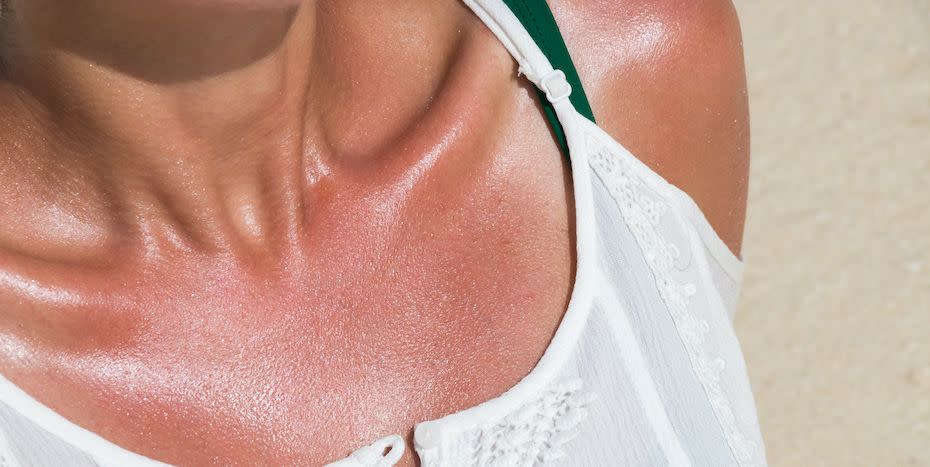Yes, you can get 'sun poisoning' and this TikToker’s viral warning is proof

A woman is going viral on TikTok over claims that she developed 'sun poisoning'.
'Watch me get sun poisoning,' the woman – who goes by the username @llioeriin – wrote in the caption of the video, which showed a series of photos of her condition progressively worsening. In one slide, the woman's forehead is visibly swollen and in another, the swelling has spread to both of her eyes.
'Went for a nap and woke up to both of my eyes swollen,' she added, alongside a photo of her inflamed face. 'Both of my eyes were shut and I couldn't see anything.'
Towards the end of the TikTok, the woman shared photos of the skin on her face which had started to peel after a few days, and reminded viewers to always wear sunscreen.
Understandably, TikTokers in the comments section were concerned about the woman's wellbeing and had plenty of questions about what sun poisoning is and how you can develop it.
'New fear unlocked,' one person commented, with another writing: 'Omg sun poisoning is literally the worst.'
What is sun poisoning?
'Sun poisoning is a term used if someone gets severe sunburn associated with systemic symptoms such as fever, headache, nausea, vomiting, dizziness and feeling generally unwell,' explains Dr Deborah Lee at Dr Fox Online Pharmacy, noting that the medical term is polymorphic light eruption.
What are the signs and symptoms of sun poisoning?
Dr Lee explains that if you have developed sun poisoning, you might first notice a red rash on your skin. 'There may be raised red spots or blisters,' she says, noting that this can also affect areas that haven't been exposed to the sun. 'Although the rash often appears within hours of sun exposure, it may not appear for two to three days,' the expert adds.
'The exposed skin will be red, swollen, often blistered and painful,' she adds of the symptoms of sun poisoning, noting that 'in due course the skin peels.'
'As these skin changes occur, the person starts to feel unwell, with a fever, chills and then feeling and/or being sick,' Dr Lee explains. 'There is a risk of dehydration, often linked to headache, confusion and sometimes fainting or collapse.'
Commenting on the symptoms experienced by the TikToker above, Dr Lee said it's tricky to know for sure whether she experienced sun poisoning or an allergic reaction, as there's crossover with some of the symptoms (such as swelling).
Who can get sun poisoning?
'Some people are more at risk of sun poisoning,' Dr Lee tells us, noting that that those with 'fair skin that doesn't tan easily' or people on 'medication such as oral contraceptives' could be at a greater risk. People using retinoids, non-steroidal anti-inflammatories and St John’s Wort may also be at a greater risk of getting sun poisoning, as well as anyone who has recently used a chemical peel on their skin.
'For those who are susceptible, even exposure to sunlight through the window or through thin fabric can be enough to set it off,' she notes.
How does sun poisoning differ from sunstroke or heat rash?
'Sunstroke occurs when your body temperature has exceeded 40 degrees celsius,' Dr Lee points out. 'It is a serious condition associated with low blood pressure, confusion, collapse and even seizures,' she adds, emphasising that sunstroke is a 'medical emergency'.
Another sun-related health condition to be aware of is heat rash, which is often called prickly heat. '[This] is caused by blocked sweat glands,' Dr Lee explains, adding that 'little pockets of sweat appear under the skin as tiny blisters.'
Typically, heat rash is 'a mild condition which usually settles over a few days with simple treatment such as calamine lotion.'
How can you protect yourself from sun poisoning?
Dr Lee explains that there are a number of things you can do to protect yourself from sun poisoning, which include:
Avoiding the midday sun (between 11am and 3pm)
Using sunscreen (with an SPF of at least 30) and reapplying this every two hours
Sitting in the shade and using a higher SPF if you've had sun poisoning before
Wearing long-sleeved clothing, trousers and a sun hat
Wearing sunglasses with UV400 protection
This article is not intended to be a substitute for professional medical advice or diagnosis. Always seek the advice of your physician or other qualified health provider with any questions you may have regarding a medical condition.
You Might Also Like

 Yahoo News
Yahoo News 
